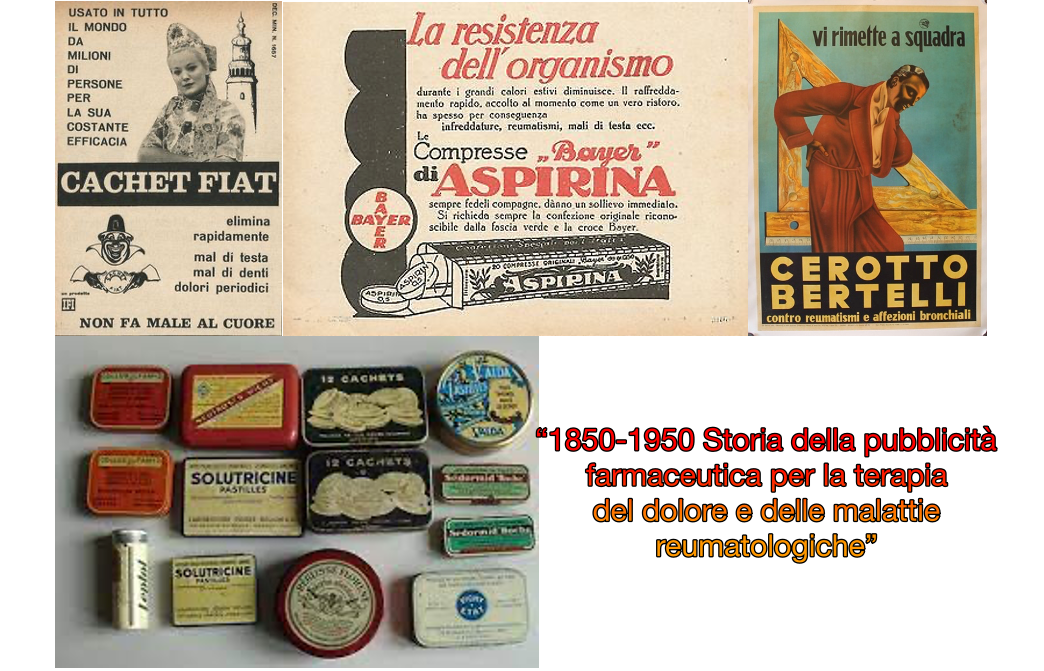Rheumatology, the exhibition of advertising for pain therapy is underway
The "1850-1950 History of pharmaceutical advertising for the treatment of pain and rheumatological diseases" initiative is held in Perugia (from 7 to 17 July at the Cloister of the Cathedral of San Lorenzo)
A unique cultural initiative of its kind, promoted by the Italian Society of Rheumatology (SIR) and which is presented today with a national online press conference. The organization of the event, as well as the technical-scientific secretariat, is entrusted to the Institute of History of Rheumatology, born at the end of 2020 from an idea of SIR.
The exhibition follows the long itinerary of how this particular form of advertising was born, evolved and what influence it has had on the type of approach to increasingly widespread diseases, such as rheumatology. The various works on display are thus also the historical testimony of the desire for greater well-being on the part of patients who, yesterday as today, are grappling with the most obvious and difficult manifestation of rheumatological pathologies: pain.
“Il nostro Istituto è nato con l’obiettivo di unire la ricerca storica con quella medica – afferma il prof. Leonardo Punzi, Direttore dell’Istituto di Storia della Reumatologia -. Siamo perciò orgogliosi di promuovere un’iniziativa prestigiosa che può avere diverse chiavi di lettura. La pubblicità è nata a metà ‘800 in seguito alla seconda rivoluzione industriale e all’immissione in commercio di numerosi prodotti.
La svolta è arrivata nel 1897 quando è stata inventata l’aspirina e qui si è assistito ad una vera rivoluzione. Il boom d’interesse creato dal nuovo farmaco, sia analgesico che antinfiammatorio, ha condizionato le aziende farmaceutiche, la ricerca scientifica e anche la pubblicità”. “La pubblicità testimonia anche l’evoluzione della percezione delle malattie reumatologiche che a metà ‘800 erano ancora poco conosciute – aggiunge il prof. Roberto Gerli, Presidente Nazionale SIR -. L’unica nota, diagnosticata e studiata sufficientemente era la gotta che veniva considerata come una patologia da ricchi e da aristocratici perché strettamente collegata al consumo abbondante di carne rossa e selvaggina.
In the mid-1900s knowledge in terms of pathogenesis, diagnosis and epidemiology had already grown enormously compared to a hundred years earlier. This also applies to therapies, so much so that in 1948 we arrive at the first use of cortisone, another drug that has revolutionized rheumatology and medicine in general".
“Ora sappiamo che le malattie reumatologiche sono oltre 150 e che solo in Italia colpiscono più di cinque milioni e mezzo di persone – prosegue Punzi -. Ovviamente rispetto alla seconda metà dell’Ottocento la scienza ha fatto passi da giganti e vi è stata, nel corso degli anni, l’introduzione di terapie estremamente più efficaci sia per la gestione del dolore che dell’infiammazione”. “Come Società Scientifica siamo da tempo
Nel chiostro della Cattedrale di San Lorenzo sono esposte oltre 100 opere artistiche realizzate tra metà ‘800 e metà del ‘900. “A cavallo tra il 19° e il 20° secolo le aziende si sono rivolte ai grandi artisti dell’epoca che hanno saputo rappresentare il fermento delle grandi trasformazioni che stavano avvenendo nella società – aggiunge la dott.ssa Elisabetta Pasqualin, Direttrice del Museo Nazionale Collezione Salce di Treviso -. E’ nata così una nuova forma d’arte che è diventata sempre più importante nel corso del ‘900. Nella mostra presentiamo dei manifesti di altissimo valore artistico e che hanno al tempo stesso anche una valenza sociale e culturale importante. La pubblicità, anche quella farmaceutica, ha consentito una “democratizzazione” dell’arte, rendendola fruibile a tutti, senza alcuna distinzione, nelle strade o nelle stazioni delle città”.
As the city of Perugia we are pleased to host this exhibition, both for its scientific contents but also for the captivating key chosen which allows us to observe the change in pain therapy over time - concludes Leonardo Varasano, Councilor for Culture of the Municipality of Perugia - . On the one hand, in fact, we are presented with the history of pharmacological development through the observation of advertising posters, but on the other, this macro theme also allows us to observe the historical-artistic evolution of style and customs that took place over 100 years. I therefore believe that this exhibition, despite having pain therapy as its specific focus, also proposes the historical-artistic and social changes that have occurred over time, making it accessible to a wider audience and not just to doctors and specialists.
Related news: The birth of scientific drug information: from its origins to the present day. Semi-serious story
